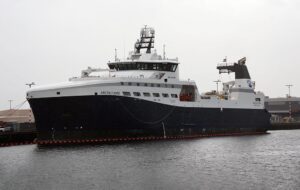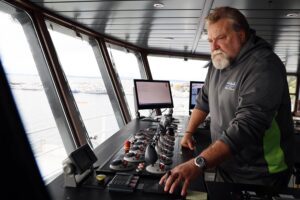
New pollock-surimi catcher-processor departs Seattle for working life in the Bering Sea.
The next time someone glibly states that “America just doesn’t make anything anymore,” you may want to shove this article in their face.
The brand new, 99.3-meter (326-foot) Arctic Fjord factory trawler of Seattle-based Arctic Storm Management Group departed Puget Sound in October, bound for her inaugural working season after a harrowing five-year build-and-deliver saga through hurricane and pandemic challenges.
The Rolls-Royce-designed vessel, dubbed a Rolls-Royce NVC 336 WP, is touted by the company as the largest fishing vessel ever built in the United States. She’s also the first American-built new vessel for the wild Alaska pollock catcher-processor fleet in over 30 years.
Arctic Fjord was built in Louisiana by Thoma-Sea Marine Construction as part of a $20 million contract. Crowley Maritime reportedly played an oversight role in construction.

Arctic Fjord buzzed with activity in the week leading up to cast off. The first batch of crewmembers took to their bunks while systems experts completed final checks at glowing computer screens.
Products from the boat will include surimi for sushi, Macdonald’s fillet-o-fish sandwiches, high quality pet food ingredients, fertilizer for crops, fish oil for health supplements and other everyday goods.
“A few of us have been on here since May,” said Arctic Fjord master Eric Wiechmann when interviewed in the state-of-the-art wheelhouse. Wiechmann and others shepherded the final stages of the build and ultimately took possession of the vessel for delivery through the Panama Canal and uphill to Puget Sound.
He, the crew, and other invested parties were eager for Arctic Fjord to get to work, especially after completing a series of offshore gear tests that went well.
“(I’m excited about) getting going,” Wiechmann said. “Bringing up some big bags of fish and get this thing producing … get the paychecks going here, let’s get this thing moving.”
Wiechmann had good things to say about the delivery experience with the vessel.
“(It was) excellent,” he said. “Seventeen knots of cruising speed. Plenty of power, stability is incredible on this boat. I’ve never seen a boat like it, where it does not have to worry about loading too much fuel or too little product. It’s excellent so far.”

The previous, now-retired Arctic Fjord was moored down the dock. A comparison between the two trawlers is a bit like one of those illustrations showing proto humans evolving into homo sapiens.
Wiechmann was master of the former Arctic Fjord while the new one was under construction to keep the money flowing.
“The old one (Arctic Fjord), I was on that one for the christening too,” he remarked. “It was called the Michelle Irene back in the day. But yeah, just the extra power and maneuverability and there’s a little more technology going on these days. It’s night and day.”
As far as notable features, Wiechmann eagerly highlighted the high-tech wheelhouse.
“We’re just getting a lot of this stuff going,” he said. “The neat thing is the middle screen. I can display whatever I want. This is what we call the matrix, we can shuffle (information). But using this screen, I can move these other screens around. I can send this stuff back there and over to the other wing station over there as well. That’s a pretty cool feature.”
While the tech is new, the core of the vessel still feels very familiar to Wiechmann. Notably, Arctic Fjord has opted for traditional hydraulic systems instead of going electric.
“Pretty much everything is still nuts and gear and levers and handles and hydraulics,” he noted. “We didn’t go electrical on the winch package. A lot of people have converted to electric, but we decided to stick with hydraulic because that worked for us.”
One new feature he was keen to highlight was the retractable third wire davit on the stern that hopefully reduces impact on seabirds.
“We’re going to test out to see if the third wire keeps birds away from it…occasionally back in the day, the wires might get too far back and there’s a lot of birds coming up behind the boat and get hung up on the wire,” he said.
“So, this will allow us to bring it down and keep birds from getting tangled in there,” he added. “You don’t see it often, but occasionally and we’re going to give it a try.”
If successful, the wire setup could be a model to reduce environmental harm for other large commercial fishing vessels.
“I’ve worked commercial fishing for 30 years,” said Craig Anderson, an operations lead with Arctic Storm Management Group who toured us through the rest of the vessel. Like Wiechmann, Anderson also has experience working on the previous Arctic Fjord. On deck, we check out the net reels.
“We’ve got four net reels,” Anderson said. “During pollock we’ll probably target 180 to 200 tons of fish at a time. We’re hoping to do 750 to 1,000 tons of fish a day when we’re up in Alaska.”
The fish will be dumped into tanks before being transported across the flow scale to be sorted. All the catch is weighed before being sorted.
When all is going well, both a starboard and port net will be working, each with a fully functioning backup net ready to deploy if needed.
“We’ll pull up one net on one side, and then we’ll use another net on the other side,” explained Anderson. “We can hold about 230 tons down below, so we’ll add another 100 or 200 tons up here to put some age on them. We don’t like to cut the fish when they’re real bloody. Nobody wants a pink fillet of fish.” According to Anderson, they aim for about four hours of aging before processing begins.
“You definitely want to have extra nets in case something gets torn or damaged somehow,” said Anderson. “We’re used to having the upper net reels in the front and the lower net reels in the back, so (the vessel’s) design with the rollers is a little different for us. But that’s the way it’s designed, and we’re going to check it out and make it work.”
Those on the tour explored an impressive galley that can seat 64 people. Crew will be working 12 hours on, 12 hours off with a two-hour, 50-minute kick shift in-between. Four meals will be served per day every 6 hours. At the time of this writing, Arctic Fjord had 152 designated bunks for crew.
Anderson also showed off one of the lounges complete with huge wall mounted TV and comfy leather couches. I imagine these spaces will be broken in quickly by off duty crew, the fresh new car smell a distant memory.
We moved down steps into the labyrinthian guts of Arctic Fjord, the hum of the generators greeting us. The processing floor is a shiny metal cathedral of industry, the pollock and surimi processing equipment from Denmark-based Carsoe.
Anderson showed us the fish flow from fillets to surimi to fishmeal. Pollock, thanks to its higher market value, is the preferred quarry over hake.
“This table here is where we sort the roe,” Anderson pointed out. “Called the Fisken table…the roe at this table will be graded and then go down here.”
The countless extrusions, packagings, scalings, and more processes all lead down into the real belly of the beast—the cold storage.
“We have three decks of fishmeal (storage) and two decks of frozen,” Anderson explained, showing off the echoing, cavernous spaces. “There’s not many boats that have two storage decks…we can have more supplies upstairs and be loading down here. I personally prefer two decks.”
An entire forklift with elevator connects the various spaces.
“There’s not many other boats that use a forklift elevator the whole way down,” Anderson remarked. “Some started to, but they ran away from it. We’re going to try it again.”
The jaw dropping, two-deck ammonia-CO2 refrigeration system is one of the topline modern features of the Arctic Fjord.
“That’s new for me, that ammonia-CO2 system is way faster than the old Freon,” Anderson said, adding that while it’s expensive upfront, the speed and efficiency of the system is anticipated to pay off in the long run.
Perhaps the most notable design feature at a glance is the pelican-like bow shape, tall with smooth topsides.
“I believe it was designed like that for rougher weather,” Anderson said. The vessel’s length of 99.3 meters (325.7 feet) was deliberate to avoid the greater regulatory hurdles of vessels over 100 meters in length.
“Quality is the name of the game,” Anderson said with pride.
Two primary working seasons beckon from the Bering Sea, ‘A’ season for pollock and ‘B’ season for hake. ‘A’ season’s opening is Jan. 20, ‘B’ season, which is hake season, usually opens in the spring and closes end of November.
Between chasing Bering Sea pollock and hake, the boat will be working off the coast of Oregon and Washington. For Arctic Fjord, the work will be year-round—just what she’s designed for.
